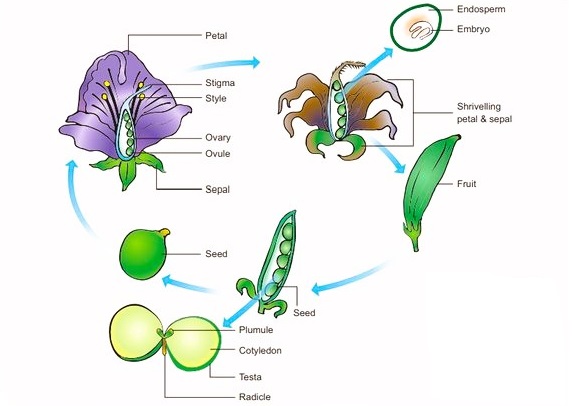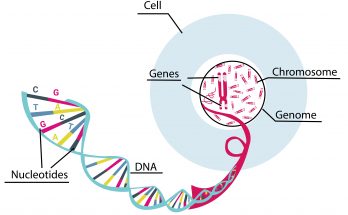Table of Contents
What are Angiosperms?
Angiosperms, also known as flowering plants, are the most diverse group of plants in the plant kingdom, with approximately 300,000 known species. They are vascular seed plants characterised by features that include flowers and enclosed ovules. Angiosperms are unique in that their seeds develop inside an organ (the ovary), which is part of the flower. After fertilisation, the ovary often develops into a fruit, which surrounds the seed and aids in its dispersal. This group includes a wide range of plants, from small annual herbs to large perennial trees, encompassing a vast array of ecological adaptations that make them prevalent across most habitats on Earth.
Characteristic Features of Angiosperms
Flowers and Reproduction-
- Flowers contain both male and female reproductive structures.
- Fertilisation occurs within an enclosed ovary, which differentiates angiosperms from gymnosperms.
Also Check – 10 Key Differences Between Angiosperms and Gymnosperms
Fruit and Seed Development-
- Fruits develop from the maturing floral organs, enclosing the seeds, which aids in seed protection and dispersal.
Diverse Forms-
- Angiosperms exhibit a wide range of forms from small herbs to large trees.
- Angiosperms are a large group of plants occurring in a wide range of habitats. They range in size from tiny, almost microscopic Wolfia to tall trees of Eucalyptus (over 100 metres).
- Structural diversity includes woody and herbaceous forms, with annual, biennial, and perennial life cycles.

Root Systems-
- Two main types of root systems- taproot and adventitious.
- Roots may be modified for functions like storage or specialised respiration (pneumatophores in mangroves).
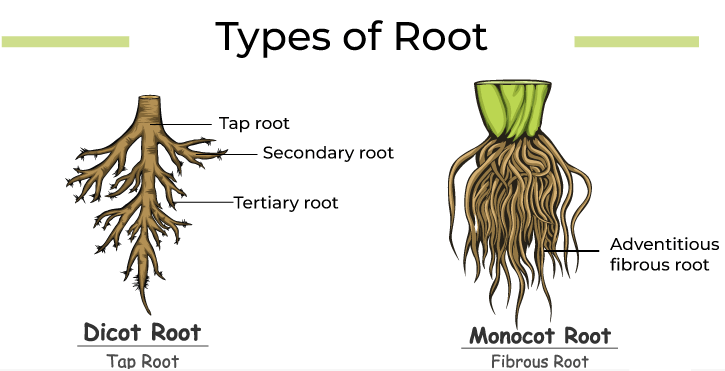
Stems-
- Stems serve as the main support structure, carrying nutrients and water between roots and leaves.
- Can be modified into structures like tubers for food storage.
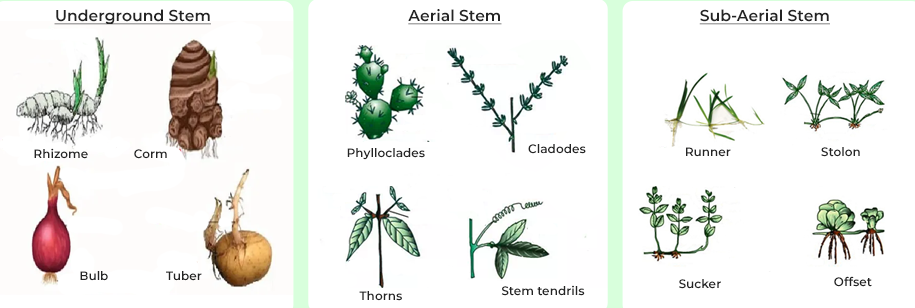
Leaves-
- Primary site for photosynthesis.
- Can be simple or compound, with diverse shapes and arrangements.
- Modifications include tendrils for climbing and spines for protection.
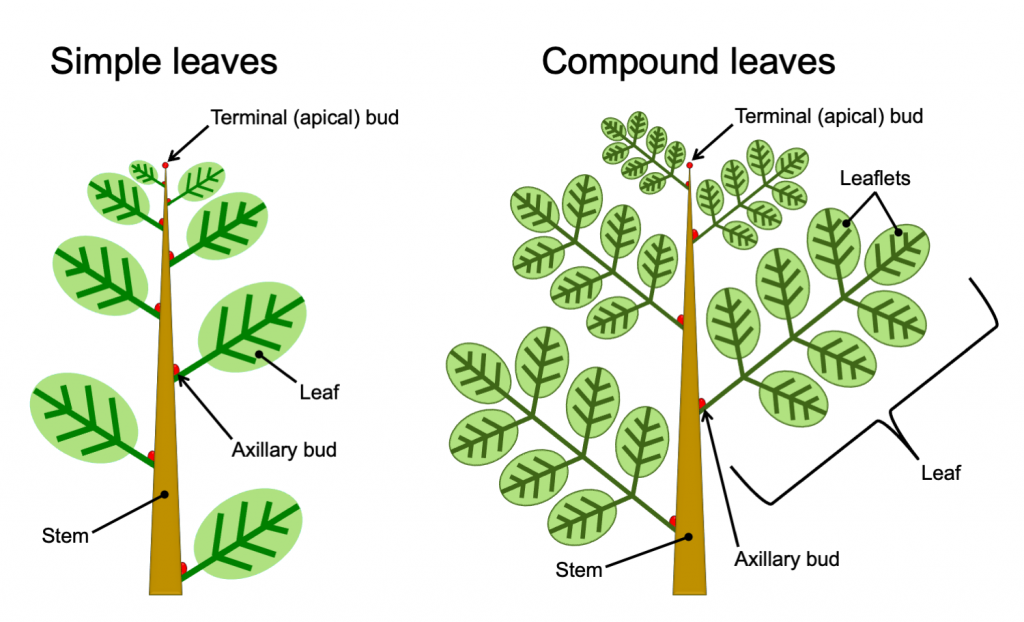
Vascular System-
- Composed of specialised tissues, xylem and phloem, for efficient transport of water, nutrients, and sugars.
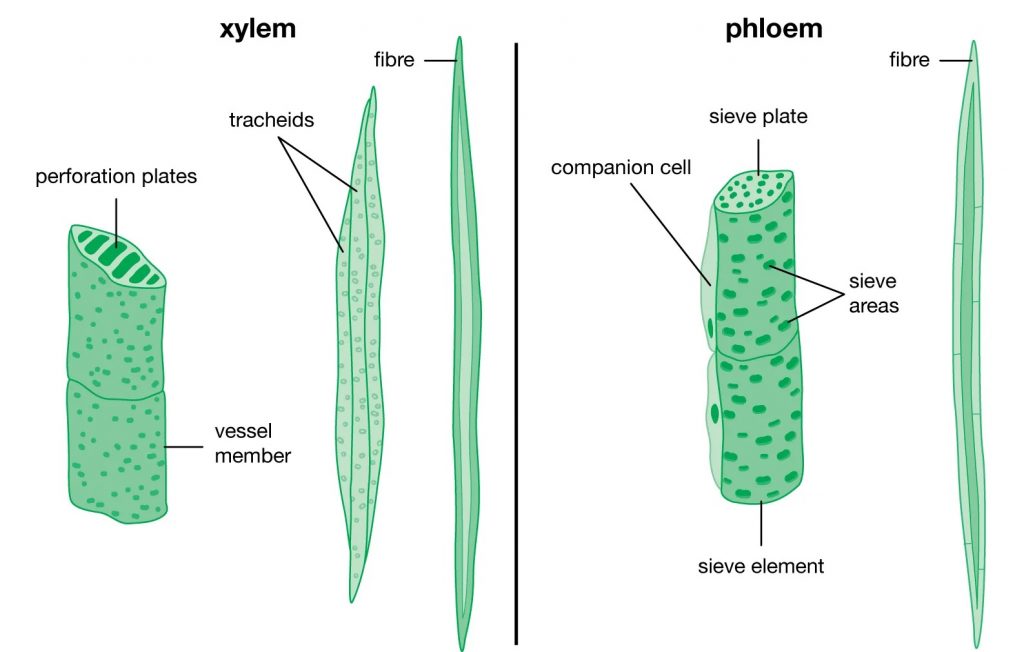
Specialised Cells and Tissues-
- Presence of meristematic tissues that allow continuous growth and development.
Ecological and Geographical Adaptability-
- Angiosperms are adaptable to a wide range of habitats, from deserts to aquatic environments.
- Dominant in most terrestrial ecosystems and critical for biodiversity.
Economic and Ecological Importance-
- Source of food, pharmaceuticals, fibre, and other materials.
- Play a pivotal role in ecological interactions and the global food chain.
Classification of Angiosperms
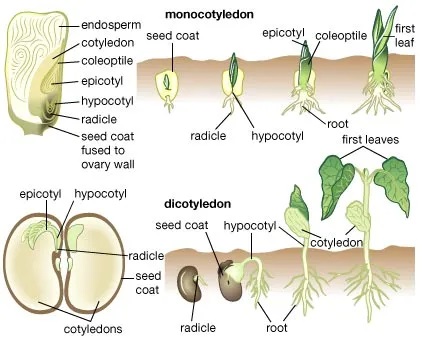
1. Monocotyledons (Monocots)
- Cotyledon- Monocots have a single cotyledon in their seeds.
- Root System- Typically possess adventitious roots, where the root system does not arise from the seed’s radicle.
- Leaf Structure- Leaves are simple with parallel venation, where veins run parallel to each other across the length of the leaf.
- Floral Structure- Floral organs are arranged in multiples of three in each whorl.
- Vascular Bundles- The vascular bundles are numerous and scattered throughout the stem without a definite arrangement.
- Examples- Includes plants like bananas, sugarcane, and lilies.
2. Dicotyledons (Dicots)
- Cotyledon- Dicots have two cotyledons in their seeds.
- Root System- Characterised by a tap root system, which develops from the enlarging radicle of the seed.
- Leaf Structure- Leaves show reticulate venation, creating a network of vein connections throughout the leaf.
- Floral Structure- Flowers are typically tetramerous (four parts) or pentamerous (five parts), with floral organs arranged accordingly.
- Vascular Bundles- Vascular bundles are arranged in a ring within the stem, which is typical of most dicots.
- Examples- This group includes plants such as grapes, sunflowers, and tomatoes.
Structure and Functions of Angiosperms
1. Basic Organization-
- Angiosperms are organised into three primary structures- roots, stems, and leaves, each made up of three types of tissue systems—dermal, ground, and vascular tissues.
- These structures develop from a fertilised egg known as a zygote, which divides mitotically to form an embryo and eventually matures into the complex structure of the plant.
2. Vegetative Structures-
- Roots- Anchor the plant and absorb water and nutrients from the soil. Roots contain a root cap that protects the root as it grows through the soil.
- Stems- Support the plant and act as conduits for the transport of nutrients and water. Stems contain nodes (where leaves attach) and internodes (the segments between nodes).
- Leaves- Main sites of photosynthesis, where sunlight is converted into chemical energy.
3. Tissue Systems-
- Dermal Tissue- The protective outer covering of the plant, primarily composed of the epidermis that guards against water loss and injury.
- Ground Tissue- Fills the interior of a plant and includes various cell types like parenchyma for storage and photosynthesis, collenchyma for support and flexibility, and sclerenchyma for structural strength.
- Vascular Tissue- Includes xylem and phloem. Xylem transports water and dissolved minerals from the roots to the rest of the plant, while phloem distributes sugars produced by photosynthesis from the leaves to other parts of the plant.
4. Meristems-
- Growth in angiosperms is facilitated by meristems, regions of actively dividing cells. The primary meristems are the apical meristems located at the tips of roots and shoots, contributing to lengthwise growth.
- Secondary growth involving the vascular cambium and cork cambium adds girth to the stems and roots, characteristic of woody plants.
5. Reproductive Structures-
- Flowers are the reproductive structures of angiosperms, containing male (stamens) and female (carpels) organs. Pollination leads to fertilisation, resulting in the formation of seeds within fruits.
6. Specialised Functions-
- Angiosperms exhibit specialised functions such as nitrogen fixation in roots, or adaptations like thorns and tendrils for protection and support.
- They also have unique adaptations to various environments, such as thick cuticles and sunken stomata for desert species or large, flat leaves for aquatic species.
7. Adaptations for Survival-
- Angiosperms have evolved various survival strategies including diverse leaf structures for efficient photosynthesis and water conservation, deep or widespread root systems for water and nutrient absorption, and specialised reproductive strategies to ensure species continuation.
Also Check – The Big Bloom—How Flowering Plants Changed the World
Reproduction in Angiosperms
Floral Structure of Angiosperms-
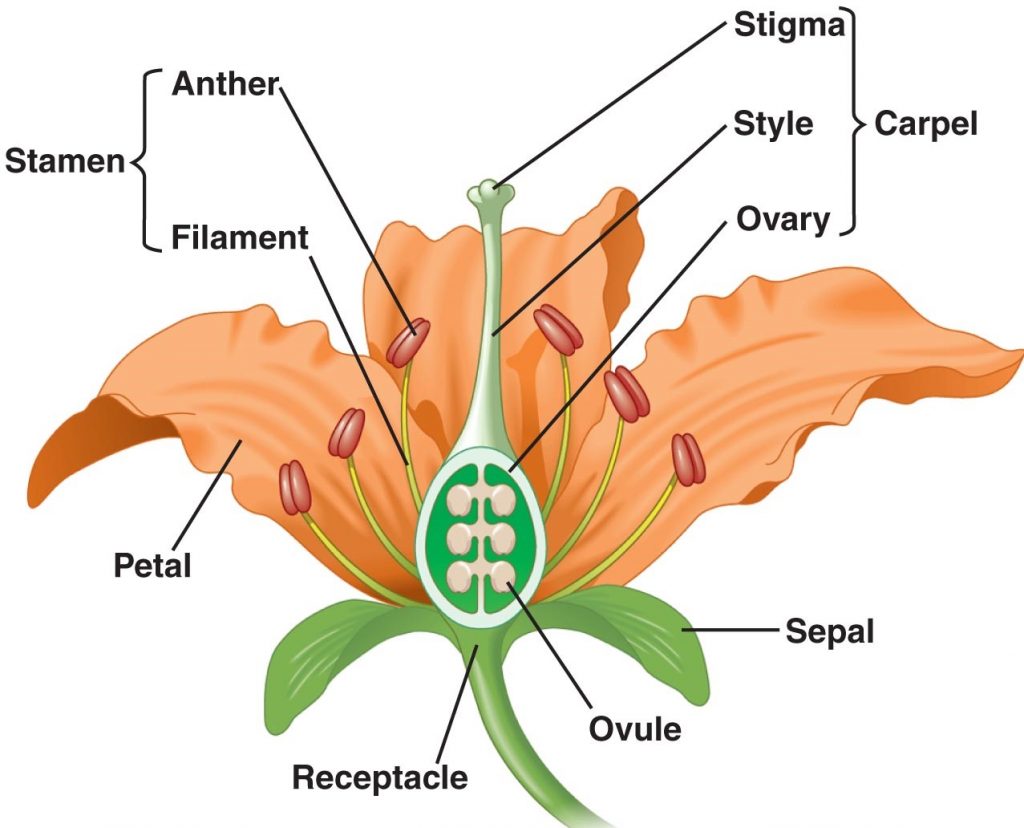
Angiosperms are distinguished by their unique ability to produce flowers, which consist of four main parts organised into whorls-
- Calyx- The outermost whorl made up of sepals, typically green, that protects the flower bud.
- Corolla- Composed of petals, usually brightly coloured to attract pollinators such as bees and butterflies.
- Androecium- The male reproductive part, consisting of stamens. Each stamen contains a filament and an anther, where pollen grains are produced.
- Gynoecium- The female reproductive structure, comprising one or more carpels. Each carpel includes a stigma, style, and ovary. The ovary contains ovules, each with a protective nucellus, two integuments, and a micropyle.
Reproductive Events in Angiosperms-
Reproduction in angiosperms involves three main stages-
Pre-Fertilization Events-

- Formation of Male Gametophyte- Pollen grains, the male gametophytes, are produced in the anthers. Each pollen grain, formed after meiosis of microspore mother cells, ultimately carries two male gametes.
- Formation of Female Gametophyte- The female gametophyte, or embryo sac, develops within the ovule in the ovary. A diploid megaspore mother cell undergoes meiosis to produce four haploid megaspores, one of which survives and divides mitotically to form the multicellular embryo sac.
Pollination-
- Pollen grains are transferred from the anther to the stigma of a flower, typically via wind, water, or pollinators. This crucial step ensures that male gametes can reach the female gametophytes for fertilisation.
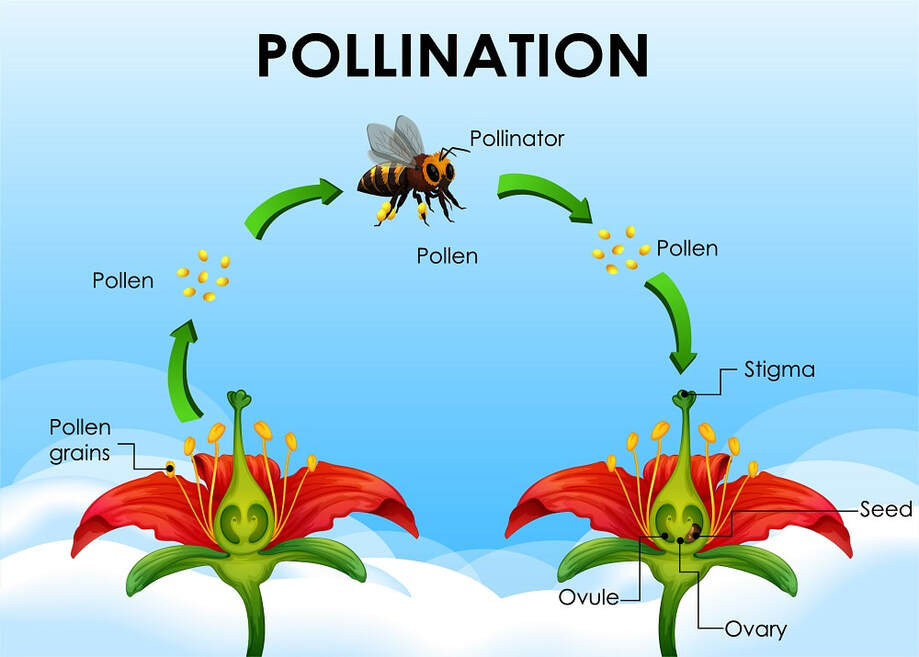
Fertilisation and Development-
- Pollen Tube Formation- Once on the stigma, a pollen grain germinates, forming a pollen tube that grows through the style to reach the ovule.
- Double Fertilisation- Unique to angiosperms, this process involves two fertilisation events-
- One sperm cell fuses with the egg cell to form a zygote, which will develop into the embryo.
- The second sperm cell fuses with the central cell, which contains two polar nuclei, to form a triploid primary endosperm nucleus (PEN), initiating endosperm formation, which nourishes the developing embryo.

Post-Fertilization Events-
- Following fertilisation, the zygote develops into an embryo, and the PEN gives rise to the endosperm. The ovary matures into a fruit, enclosing the seeds, which develop from the fertilised ovules. The fruit aids in seed dispersal and protection.
